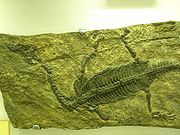
Lariosaurus
Encyclopedia
Lariosaurus is an extinct genus of nothosaur
from the Triassic
period of northern Italy. With a length of just 60 centimetres (2 ft), it was one of the smallest known nothosaurs. It was named in 1847 by Curioni, its name meaning "Lizard (from Lake) Lario".
The nothosaur Eupodosaurus, initially classified as a stegosauria
n dinosaur
, is now considered synonymous with Lariosaurus.

 For a nothosaur, Lariosaurus was primitive, possessing a short neck and small flippers in comparison to its relatives. This would have made it a relatively poor swimmer, and it is presumed to have spent lots of time on dry land, or hunting in shallows.
For a nothosaur, Lariosaurus was primitive, possessing a short neck and small flippers in comparison to its relatives. This would have made it a relatively poor swimmer, and it is presumed to have spent lots of time on dry land, or hunting in shallows.
Lariosaurus unique among nothosaurs because its front legs were adapted into paddles, while the back legs remained five-toed. Further, based on skeletal findings of immature lariosaurs inside the adults, Lariosaurus is believed by many to be viviparous, or able to bear live young. Another Lariosaur skeleton was found with two juvenile placodont
s of the Cyamodus
genus in its stomach, giving an indication of its diet.
Nothosaur
Nothosaurs were Triassic marine sauropterygian reptiles that may have lived like seals of today, catching food in water but coming ashore on rocks and beaches. They averaged about in length, with a long body and tail. The feet were paddle-like, and are known to have been webbed in life, to help...
from the Triassic
Triassic
The Triassic is a geologic period and system that extends from about 250 to 200 Mya . As the first period of the Mesozoic Era, the Triassic follows the Permian and is followed by the Jurassic. Both the start and end of the Triassic are marked by major extinction events...
period of northern Italy. With a length of just 60 centimetres (2 ft), it was one of the smallest known nothosaurs. It was named in 1847 by Curioni, its name meaning "Lizard (from Lake) Lario".
The nothosaur Eupodosaurus, initially classified as a stegosauria
Stegosauria
Known colloquially as stegosaurs, the Stegosauria are a group of herbivorous dinosaurs of the Jurassic and Early Cretaceous Periods, being found mostly in the Northern Hemisphere, predominantly in what is now North America and China....
n dinosaur
Dinosaur
Dinosaurs are a diverse group of animals of the clade and superorder Dinosauria. They were the dominant terrestrial vertebrates for over 160 million years, from the late Triassic period until the end of the Cretaceous , when the Cretaceous–Paleogene extinction event led to the extinction of...
, is now considered synonymous with Lariosaurus.


Lariosaurus unique among nothosaurs because its front legs were adapted into paddles, while the back legs remained five-toed. Further, based on skeletal findings of immature lariosaurs inside the adults, Lariosaurus is believed by many to be viviparous, or able to bear live young. Another Lariosaur skeleton was found with two juvenile placodont
Placodont
Placodonts were a group of marine reptiles that lived during the Triassic period, becoming extinct at the end of the period. It is believed that they were part of Sauropterygia, the group that includes Plesiosaurs...
s of the Cyamodus
Cyamodus
Cyamodus was a placodont, known from fossil remains discovered in Germany, in the early-to-mid-19th century and was named by Christian Erich Hermann von Meyer, in 1863. The fossils have been dated to the Triassic Period, from the Anisian to Ladinian stages...
genus in its stomach, giving an indication of its diet.

